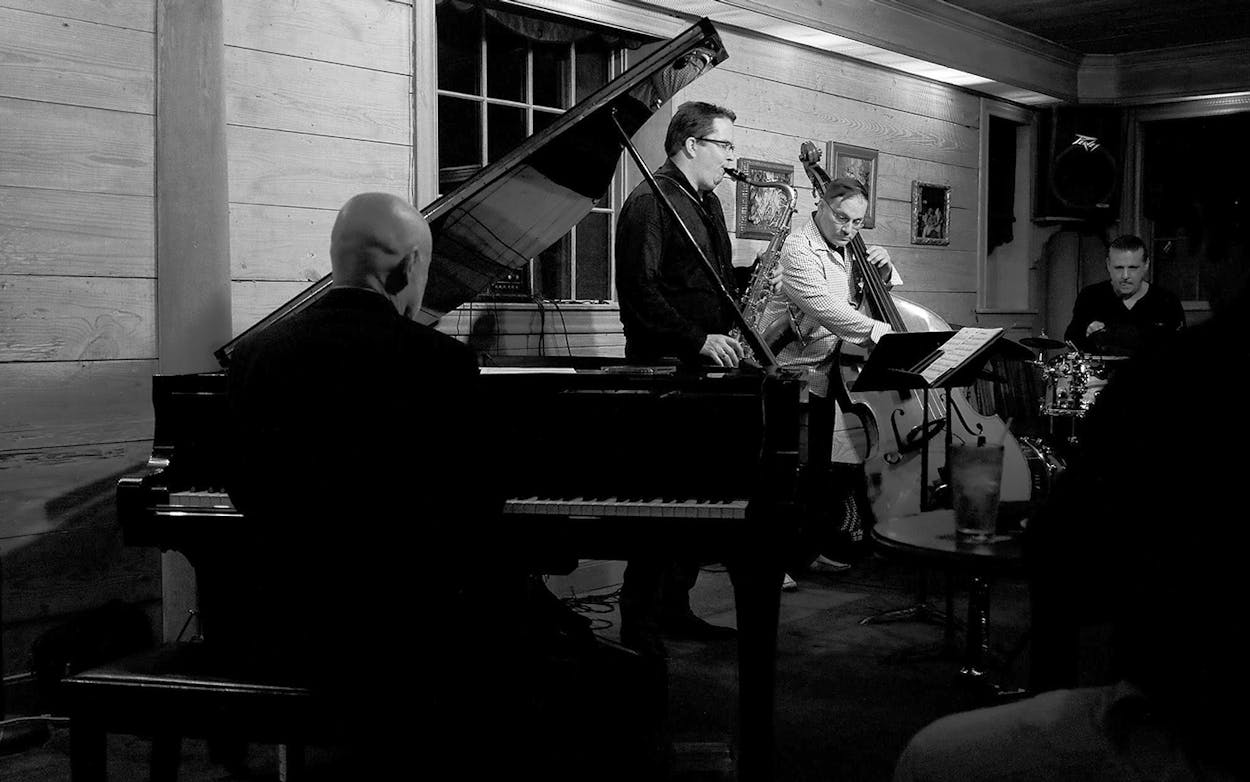On a recent Thursday afternoon, office workers navigating the hinterlands of downtown Houston’s underground tunnel system may have noticed the sound of a saxophone emanating from a set of heavy double doors. Behind the doors was the basement party room of Birraporetti’s Italian restaurant, where musician Woody Witt was testing out the acoustics.
“It’s more live than the old club,” Witt said, setting down his saxophone. “I think it’s because we have sheetrock walls rather than wood, plus we have acoustic ceiling tiles. We won’t know for sure until we fill the space with people, but I think it will sound better.”
The old club was Cezanne, Houston’s premier live jazz venue, which occupied an intimate, second-story space in Montrose from the mid-eighties until last year, when its landlord, the University of St. Thomas, decided to demolish the building to make room for a new retail development. On March 6, the club will reopen at Birraporetti’s in the heart of Houston’s theater district. Owned and managed by Witt, a veteran musician and teacher, the new Cezanne will offer sets at 9 and 10:45 p.m. on Friday and Saturday nights—just like the old club.
The closure of Cezanne left a void at the center of Houston’s jazz scene. Although several other restaurants and bars offer live jazz, Cezanne was the city’s only “listening room,” a place where people came primarily to hear music, like New York’s Village Vanguard or Chicago’s Green Mill. Only a handful of listening rooms exist in Texas: Fort Worth’s Scat Jazz Lounge, San Antonio’s Jazz TX, and Elephant Room and Parker Jazz Club in Austin. (Austin also has Monks Jazz Club, a pop-up concert series.)
“I’ll never forget the first time I played at Cezanne,” said Austin drummer Daniel Dufour. “I was playing all these bar gigs, which are great. But it’s different to have the audience sitting down right next to your drums, looking at you and sort of wondering what you have to offer. Even if they walk away not liking it, that’s better than them sitting in the back with their beers and not realizing a band is playing.”
Cezanne opened in 1986 above the the Black Labrador, a British-themed restaurant and pub. The first programming director was pianist Dave Catney, who is widely credited with putting the club on the map. After Catney’s death in 1994, booking duties were assumed by a series of Houston musicians, culminating in Witt, who has overseen the club for the past fifteen years.
“Some of the best nights I remember from the old days at Cezanne were Woody’s band,” said jazz writer Rick Mitchell, a music critic for the Houston Chronicle from 1989 to 1999. Mitchell recalls Witt’s 1997 performance of John Coltrane’s A Love Supreme as “one of the great moments of live jazz in Houston. It’s sort of an insult to call a guy like Woody local. He’s local because he stayed in Houston, but he’s a national-class talent. And that’s true of many other players around town.”
Some of today’s biggest international jazz stars hail from Houston, including Jason Moran, Robert Glasper, and Eric Harland, all of whom attended Houston’s legendary High School for the Performing and Visual Arts. In 2011, Moran organized two nights of concerts in New York featuring only Houston musicians. For the most part, musicians have had to leave Houston to find major-label success. “It’s always been perplexing to me that in a city this size—this huge, modern, supposedly sophisticated city—we could only keep a jazz club open two nights a week,” said Houston trumpeter Dennis Dotson, another Cezanne regular.
Mitchell has long shared that perplexity. He estimates that the jazz scene in Portland, Oregon, where he now lives, is about five times larger than Houston’s. “You can go broke wishing Houston was hipper than it is,” he said. “The city’s very geographically spread out. And I think that people move to Houston to have a career and raise a family, so they don’t go out as much on weeknights. They may go out to eat, but they don’t stay out late.”
But things may be changing. Thanks to a revitalized downtown and new light rail lines, Houston is more walkable than ever. Being in the theater district may help Cezanne pull in a larger, more diverse audience. “Partly because of its location and partly because of the artists who were booked in there, Cezanne was, de facto, kind of a white club,” Mitchell said. “Birraporetti’s is in a location that could attract everybody. It’s a place where white people, Hispanic people, black people, Asian people are already comfortable. You go in Birraporetti’s and you’ll see plenty of diversity.”
With seating for about 120 people, more than double the previous capacity, the new Cezanne can certainly accommodate a larger clientele. While the old location served only appetizers, Witt’s partnership with Birraporetti’s means that a larger selection of food and drinks will be available, served by a team of waiters. The cover will remain $15, although Witt would like to add a $5 weekday happy hour. Because the club hasn’t yet acquired a piano—Witt has reached out to the nearby Steinway dealership about a potential partnership—it will initially feature guitar- and keyboard-driven groups.
“There hasn’t been anything like this downtown since maybe the seventies,” Witt said. But he knows that to make the club work, he has to do more than continue booking great musicians. He has to create an atmosphere. “Traditionally, jazz takes place in these small little rooms. It’s dark and dank, people are packed in there, and there’s this energy that happens when everything’s going right. That’s what we’re trying to do here.”








